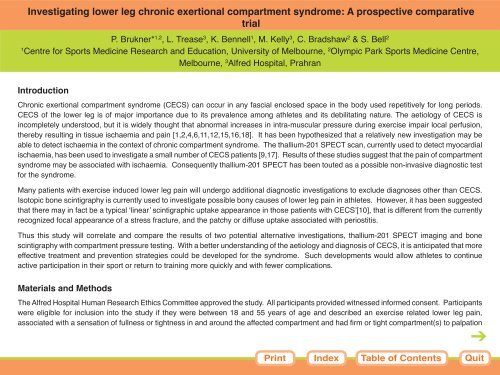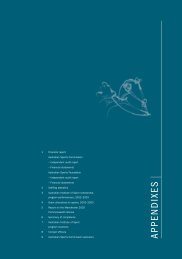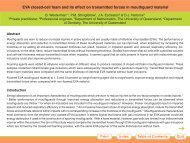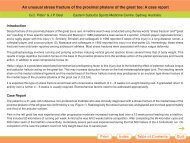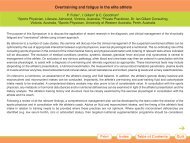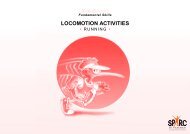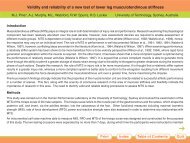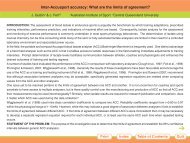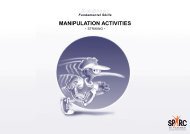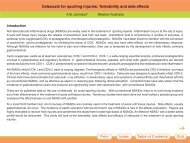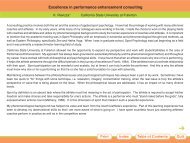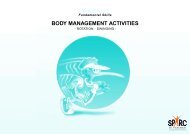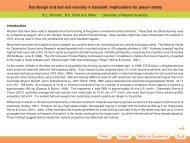Investigating lower leg chronic exertional compartment syndrome: A ...
Investigating lower leg chronic exertional compartment syndrome: A ...
Investigating lower leg chronic exertional compartment syndrome: A ...
Create successful ePaper yourself
Turn your PDF publications into a flip-book with our unique Google optimized e-Paper software.
<strong>Investigating</strong> <strong>lower</strong> <strong>leg</strong> <strong>chronic</strong> <strong>exertional</strong> <strong>compartment</strong> <strong>syndrome</strong>: A prospective comparative<br />
trial<br />
P. Brukner* 1,2 , L. Trease3 , K. Bennell1 , M. Kelly3 , C. Bradshaw2 & S. Bell2 1 2 Centre for Sports Medicine Research and Education, University of Melbourne, Olympic Park Sports Medicine Centre,<br />
Melbourne, 3Alfred Hospital, Prahran<br />
Introduction<br />
Chronic <strong>exertional</strong> <strong>compartment</strong> <strong>syndrome</strong> (CECS) can occur in any fascial enclosed space in the body used repetitively for long periods.<br />
CECS of the <strong>lower</strong> <strong>leg</strong> is of major importance due to its prevalence among athletes and its debilitating nature. The aetiology of CECS is<br />
incompletely understood, but it is widely thought that abnormal increases in intra-muscular pressure during exercise impair local perfusion,<br />
thereby resulting in tissue ischaemia and pain [1,2,4,6,11,12,15,16,18]. It has been hypothesized that a relatively new investigation may be<br />
able to detect ischaemia in the context of <strong>chronic</strong> <strong>compartment</strong> <strong>syndrome</strong>. The thallium-201 SPECT scan, currently used to detect myocardial<br />
ischaemia, has been used to investigate a small number of CECS patients [9,17]. Results of these studies suggest that the pain of <strong>compartment</strong><br />
<strong>syndrome</strong> may be associated with ischaemia. Consequently thallium-201 SPECT has been touted as a possible non-invasive diagnostic test<br />
for the <strong>syndrome</strong>.<br />
Many patients with exercise induced <strong>lower</strong> <strong>leg</strong> pain will undergo additional diagnostic investigations to exclude diagnoses other than CECS.<br />
Isotopic bone scintigraphy is currently used to investigate possible bony causes of <strong>lower</strong> <strong>leg</strong> pain in athletes. However, it has been suggested<br />
that there may in fact be a typical ‘linear’ scintigraphic uptake appearance in those patients with CECS’[10], that is different from the currently<br />
recognized focal appearance of a stress fracture, and the patchy or diffuse uptake associated with periostitis.<br />
Thus this study will correlate and compare the results of two potential alternative investigations, thallium-201 SPECT imaging and bone<br />
scintigraphy with <strong>compartment</strong> pressure testing. With a better understanding of the aetiology and diagnosis of CECS, it is anticipated that more<br />
effective treatment and prevention strategies could be developed for the <strong>syndrome</strong>. Such developments would allow athletes to continue<br />
active participation in their sport or return to training more quickly and with fewer complications.<br />
Materials and Methods<br />
The Alfred Hospital Human Research Ethics Committee approved the study. All participants provided witnessed informed consent. Participants<br />
were eligible for inclusion into the study if they were between 18 and 55 years of age and described an exercise related <strong>lower</strong> <strong>leg</strong> pain,<br />
associated with a sensation of fullness or tightness in and around the affected <strong>compartment</strong> and had firm or tight <strong>compartment</strong>(s) to palpation<br />
Print<br />
Index<br />
Table of Contents<br />
Quit
<strong>Investigating</strong> <strong>lower</strong> <strong>leg</strong> <strong>chronic</strong> <strong>exertional</strong> <strong>compartment</strong> <strong>syndrome</strong>: A prospective comparative<br />
trial<br />
P. Brukner* 1,2 , L. Trease3 , K. Bennell1 , M. Kelly3 , C. Bradshaw2 & S. Bell2 1 2 Centre for Sports Medicine Research and Education, University of Melbourne, Olympic Park Sports Medicine Centre,<br />
Melbourne, 3Alfred Hospital, Prahran<br />
following exercise. Any participant who had had previous decompressive surgery for CECS was excluded because of the unknown pathological<br />
consequences of previous surgery within the same <strong>compartment</strong>.<br />
There were 24 male and 16 female participants. The mean age of the study group was 29 years. Seven patients had unilateral symptoms and<br />
the remaining 33 had bilateral symptoms. There were 15 patients with anterior symptomology, and 14 patients with posterior symptomology,<br />
the remaining 11 patients presented with concurrent anterior and posterior symptoms. Twenty-eight participants (70%) had both the thallium-<br />
201 SPECT scan and a bone scan. Six participants (15%) consented only to a thallium-201 SPECT scans and six (15%) participated only in<br />
the bone scan part of the study. Four medical practitioners performed the <strong>compartment</strong> pressure tests using a standard testing protocol.<br />
Participants were then divided into two groups on the basis of CPT results; those with a negative CPT were classified as ‘controls’ and those<br />
with a positive CPT were classified as ‘patients’.<br />
Thallous chloride scintigraphy (thallium-201 SPECT imaging) was performed in the Nuclear Medicine Department of The Alfred Hospital,<br />
Melbourne, Australia. Thallium-201 SPECT images were analyzed quantitatively and qualitatively in a blinded and independent manner.<br />
Quantitative analysis was performed. Images obtained from an Optima NX Gamma Camera [General Electric Medical Systems, Milwaukee]<br />
were reconstructed into 11 slices each 12mm in thickness and displayed proximal to distal. Three regions of interest (ROI) were demarcated;<br />
the antero-lateral <strong>compartment</strong>, the superficial posterior <strong>compartment</strong>, and the deep posterior <strong>compartment</strong>. The mean pixel count per ROI and<br />
the maximum pixel count per <strong>leg</strong> were calculated. Quantitative data were only analyzed for those <strong>compartment</strong>s and <strong>leg</strong>s with confirmed<br />
pressure measurement values. Intra-observer reliability was calculated by repeat analysis of 240 slice data sets while inter-observer reliability<br />
was performed by comparing the analysis of 270 slice data sets with an experienced nuclear medicine technologist. Intra-class correlation<br />
coefficients for the different <strong>compartment</strong>s were 0.85-0.98 for intra-observer reliability and 0.82-0.98 for inter-observer reliability indicating<br />
excellent agreement’[14]. Qualitative analysis was performed by two experienced Nuclear Medicine Physicians with a third physician used<br />
when there was a discrepancy between the readers. Study participants were classified into one of five levels of perfusion in the stress images,<br />
and one of five levels of redistribution in the rest images. Each <strong>compartment</strong> on stress imaging was graded as either very hypoperfused (1),<br />
moderately hypoperfused (2), mildly hypoperfused (3), equally perfused (4) or hyperperfused (5) in relation to the other <strong>compartment</strong>s within<br />
the same <strong>leg</strong>. Redistribution images for each <strong>compartment</strong> were graded to have either markedly redistributed (1), moderately redistributed (2)<br />
Print<br />
Index<br />
Table of Contents<br />
Quit
<strong>Investigating</strong> <strong>lower</strong> <strong>leg</strong> <strong>chronic</strong> <strong>exertional</strong> <strong>compartment</strong> <strong>syndrome</strong>: A prospective comparative<br />
trial<br />
P. Brukner* 1,2 , L. Trease3 , K. Bennell1 , M. Kelly3 , C. Bradshaw2 & S. Bell2 1 2 Centre for Sports Medicine Research and Education, University of Melbourne, Olympic Park Sports Medicine Centre,<br />
Melbourne, 3Alfred Hospital, Prahran<br />
or mildly redistributed (3), remained unchanged (4) or to have undergone reverse redistribution (5) relative to the stress images. Scans were<br />
deemed to be positive for a <strong>compartment</strong> perfusion deficit if they had a summed stress and redistribution score of less than or equal to five.<br />
Bone scintigraphy was performed at The Alfred Hospital Nuclear Medicine Department, Melbourne, Australia using a Maxxus Gamma Camera<br />
System [General Electric Medical Systems, Milwaukee]. Following injection of 800 MBq Technetium-99m MDP, the bone scan performed was<br />
a standard three-phase procedure with images taken at three time points. Blood flow and initial uptake images were performed within half an<br />
hour of the injection. Delayed bone uptake images were performed at least three hours after the injection, when the target to background ratio<br />
was at a maximum. Interpretation of the bone scan was made using a blinded protocol.<br />
Comparisons of mean pixel ratios for stress and redistribution in the 11 slices between patients and controls were made using a mixed 2x11<br />
analysis of variance. The <strong>compartment</strong>s were combined for these analyses given the small numbers. For qualitative thallium-201 SPECT<br />
image scores and bone scintigraphy results, comparisons between groups were made using Chi square. Comparisons of symptom duration in<br />
those with and without linear uptake on bone scintigraphy was made using the Mann Whitney U test as the data were not normally distributed.<br />
An alpha level of p
<strong>Investigating</strong> <strong>lower</strong> <strong>leg</strong> <strong>chronic</strong> <strong>exertional</strong> <strong>compartment</strong> <strong>syndrome</strong>: A prospective comparative<br />
trial<br />
P. Brukner* 1,2 , L. Trease3 , K. Bennell1 , M. Kelly3 , C. Bradshaw2 & S. Bell2 1 2 Centre for Sports Medicine Research and Education, University of Melbourne, Olympic Park Sports Medicine Centre,<br />
Melbourne, 3Alfred Hospital, Prahran<br />
Participants were classified as having CECS typical linear uptake or non-linear uptake (either normal uptake, focal ovoid or diffuse patchy) on<br />
bone scintigraphy. Of those with a positive CPT result, 60% showed linear uptake on bone scan compared with 44% of those with a negative<br />
CPT result. There was no significant difference in bone scan appearance between those patients who had a positive CPT and those with a<br />
negative CPT result (X2(1)=0.65, p=0.46). The sensitivity and specificity of linear findings on bone scintigraphy for the diagnosis of CECS was<br />
60% and 56% respectively.<br />
Those patients who had a positive CPT were then separated on the basis of their involved <strong>compartment</strong>s and compared with the different linear<br />
classifications (medial [posterior], lateral [anterior] and ‘tram-track’ [combined anterior and posterior]). While the numbers in each cell are too<br />
small to permit statistical analysis of the data, it is apparent that the site of uptake on the bone scan does not correspond to the affected<br />
<strong>compartment</strong>.<br />
Discussion<br />
This study measured the muscular perfusion of participants with exercise-induced <strong>lower</strong> <strong>leg</strong> pain using thallium-201 SPECT imaging and found<br />
no difference between those participants with and without CECS as diagnosed by <strong>compartment</strong> pressure testing. These results suggest that<br />
the pathophysiology of CECS may not involve ischaemia. This concurs with the results of Amendola et.al [3] who used MRI and Baulduini et.<br />
al. [5] who used phosphorous-31 nuclear magnetic resonance (31P-NMR) SPECT. In this latter study, ischaemia was only demonstrated in<br />
those patients where intra<strong>compartment</strong>al pressure was greater than systolic blood pressure (>160mmHg), a situation which is to be expected.<br />
No participant in this study recorded CPT values higher than 110mmHg.<br />
From the results seen in this study, it is apparent that clinically, thallium-201 SPECT imaging would provide little diagnostic assistance for<br />
suspected CECS cases. Although, it was a very specific investigation for CECS, with no false positive results (100% specific), it had extremely<br />
low sensitivity and so would not be able to distinguish positive CECS cases from actual negatives.<br />
This study failed to demonstrate a relationship between raised intra<strong>compartment</strong>al pressure and linear uptake on bone scintigraphy. However,<br />
as 44% of the controls and 60% of the patients had linear uptake on bone scan it is apparent that bony changes are relatively common in this<br />
Print<br />
Index<br />
Table of Contents<br />
Quit
<strong>Investigating</strong> <strong>lower</strong> <strong>leg</strong> <strong>chronic</strong> <strong>exertional</strong> <strong>compartment</strong> <strong>syndrome</strong>: A prospective comparative<br />
trial<br />
P. Brukner* 1,2 , L. Trease3 , K. Bennell1 , M. Kelly3 , C. Bradshaw2 & S. Bell2 1 2 Centre for Sports Medicine Research and Education, University of Melbourne, Olympic Park Sports Medicine Centre,<br />
Melbourne, 3Alfred Hospital, Prahran<br />
group. Other studies in athletes with stress fractures have also noted areas of increased uptake on bone scan at asymptomatic sites [8,19]. It<br />
is possible that the changes observed on bone scintigraphy in this study are incidental findings and result from the exercise that produces or<br />
aggravates the patient’s symptoms, but are unrelated to, or independent from the actual cause of their pain. Alternatively, some patients may<br />
have more than one pathological process occurring concurrently, with both CECS and bony pathology contributing to their pain. In those<br />
patients with a negative CPT, bone pathology consistent with a stress reaction or periostitis could explain their exercise-induced symptoms.<br />
Thus, the bone scintigraphic appearance is unlikely to be clinically useful as a diagnostic indicator of CECS.<br />
Conclusion<br />
The results of this study do not support the hypotheses that ischaemia may be important in the aetiology of <strong>lower</strong> <strong>leg</strong> CECS and that tension of<br />
tight fascia on the periosteal attachment produces characteristic bony changes. Further research should focus on identifying the pathologic<br />
process and the pain mechanisms involved. Given the poor sensitivity of thallium-201 SPECT imaging and bone scintigraphy to distinguish<br />
between those with and without increased intra<strong>compartment</strong> pressure, it is recommended that the diagnosis of CECS continues to be established<br />
based on clinical findings in conjunction with <strong>compartment</strong> pressure testing.<br />
References<br />
Allen MJ, Barnes MR: Exercise pain in the <strong>lower</strong> <strong>leg</strong>. Chronic <strong>compartment</strong> <strong>syndrome</strong> and medial tibial <strong>syndrome</strong>. JBJS 1986. 68: 818-823,<br />
1986<br />
Amendola A, Rorabeck CH: Chronic <strong>exertional</strong> <strong>compartment</strong> <strong>syndrome</strong>, in Current Therapy in Sports Medicine, Torg JS, Welsh RP, Shepard<br />
RJ, Editors. Decker: Toronto, BC. p. 34, 1985<br />
Amendola A et al: The use of magnetic resonance imaging in <strong>exertional</strong> <strong>compartment</strong> <strong>syndrome</strong>s. Am J Sports Med 18: 29-34, 1990<br />
Bates P: Shin splints: A literature review. Br J Sports Med 19: 132-137, 1985<br />
Baulduini FC et al: Chronic <strong>exertional</strong> <strong>compartment</strong> <strong>syndrome</strong>: Correlation of <strong>compartment</strong> pressure and muscle ishaemia utilizing 31P-NMR<br />
spectroscopy. Clin Sports Med 12: 151-165, 1993<br />
Print<br />
Index<br />
Table of Contents<br />
Quit
<strong>Investigating</strong> <strong>lower</strong> <strong>leg</strong> <strong>chronic</strong> <strong>exertional</strong> <strong>compartment</strong> <strong>syndrome</strong>: A prospective comparative<br />
trial<br />
P. Brukner* 1,2 , L. Trease3 , K. Bennell1 , M. Kelly3 , C. Bradshaw2 & S. Bell2 1 2 Centre for Sports Medicine Research and Education, University of Melbourne, Olympic Park Sports Medicine Centre,<br />
Melbourne, 3Alfred Hospital, Prahran<br />
Black K, Taylor DE: Current concepts in the treatment of common <strong>compartment</strong> <strong>syndrome</strong>s in athletes. Sports Med 15: 408-418, 1993<br />
Breit G et al: Near-Infrared spectroscopy for monitoring of tissue oxygenation of exercising skeletal muscle in a <strong>chronic</strong> <strong>compartment</strong> <strong>syndrome</strong><br />
model. JBJS. 79-A: 838-843, 1997<br />
Ha KL et al: A clinical study of stress fractures in sports activities. Orthopaed 14: 1089-1095, 1991<br />
Hayes A, Bower G, Pitstock K: Chronic (<strong>exertional</strong>) <strong>compartment</strong> <strong>syndrome</strong> of the <strong>leg</strong>s diagnosed with Thallous Chloride Scintigraphy. J Nucl<br />
Med 36: 1681-162, 1995<br />
Kues J: The pathology of shin splints. J Orthop Sports Phys Ther 12: 115-121, 1990<br />
Martens MA, Moeyersoons JP: Acute and recurrent effort-related <strong>compartment</strong> <strong>syndrome</strong> in sports. Sports Med 9: 62-68, 1990<br />
Martens MA et al: Chronic <strong>leg</strong> pain in athletes due to a recurrent <strong>compartment</strong> <strong>syndrome</strong>. Am J Sports Med 12: 48-151, 1984<br />
Mohler LR et al: Intramuscular deoxygenation during exercise in patients who have <strong>chronic</strong> anterior <strong>compartment</strong> <strong>syndrome</strong> of the <strong>leg</strong>. JBJS<br />
79-A: 844-849, 1997<br />
Portney LG, Watkins MP, Foundations of Clinical Research, applications to practice. Connecticut: Appleton and Lange pp. 509-515, 1993<br />
Puranen J, Alavaikko A: Intra<strong>compartment</strong>al pressure increase on exertion in patients with <strong>chronic</strong> <strong>compartment</strong> <strong>syndrome</strong> in the <strong>leg</strong>. JBJS<br />
63A:1304-1309, 1981<br />
Styf J: The influence of external compression on muscle blood flow during exercise. Am J Sports Med 18: 92-95, 1990<br />
Takebayashi S et al: Chronic <strong>exertional</strong> <strong>compartment</strong> <strong>syndrome</strong> in <strong>lower</strong> <strong>leg</strong>s: Localization and follow-up with Thallium-201 SPECT imaging.<br />
J Nucl Med 1997. 38: 972-976, 1997<br />
Veith R, Matsen F, Newell S: Recurrent anterior <strong>compartment</strong>al <strong>syndrome</strong>s. Phys Sports Med 8: 80-88, 1980<br />
Zwas ST, Elkanovitch R, Frank G: Interpretation and classification of bone scintigraphic findings in stress fracture. J Nucl Med 28: 452-457,<br />
1987<br />
Print<br />
Index<br />
Table of Contents<br />
Quit
<strong>Investigating</strong> <strong>lower</strong> <strong>leg</strong> <strong>chronic</strong> <strong>exertional</strong> <strong>compartment</strong> <strong>syndrome</strong>: A prospective comparative<br />
trial<br />
P. Brukner* 1,2 , L. Trease3 , K. Bennell1 , M. Kelly3 , C. Bradshaw2 & S. Bell2 1 2 Centre for Sports Medicine Research and Education, University of Melbourne, Olympic Park Sports Medicine Centre,<br />
Melbourne, 3Alfred Hospital, Prahran<br />
Figure 1: Quantitative analysis of the mean (SD) pixel ratio of the antero-lateral <strong>compartment</strong> stress images by slice<br />
Mean pixel ratio<br />
1.0<br />
0.9<br />
0.8<br />
0.7<br />
0.6<br />
0.5<br />
0.4<br />
0.3<br />
0.2<br />
0.1<br />
0.0<br />
1 2 3 4 5 6 7 8 9 10 11<br />
Slice<br />
Print<br />
Index<br />
Positive CPT<br />
Negative CPT<br />
Table of Contents<br />
Quit
<strong>Investigating</strong> <strong>lower</strong> <strong>leg</strong> <strong>chronic</strong> <strong>exertional</strong> <strong>compartment</strong> <strong>syndrome</strong>: A<br />
prospective comparative trial<br />
P. Brukner* 1,2 , L. Trease 3 , K. Bennell 1 , M. Kelly 3 , C. Bradshaw 2 & S. Bell 2<br />
1 Centre for Sports Medicine Research and Education, University of Melbourne<br />
2 Olympic Park Sports Medicine Centre, Melbourne<br />
3 Alfred Hospital, Prahran<br />
INTRODUCTION: Chronic <strong>exertional</strong> <strong>compartment</strong> <strong>syndrome</strong> (CECS) can occur in any fascial enclosed space<br />
in the body used repetitively for long periods. CECS of the <strong>lower</strong> <strong>leg</strong> is of major importance due to its prevalence<br />
among athletes and its debilitating nature. The aetiology of CECS is incompletely understood, but it is widely<br />
thought that abnormal increases in intra-muscular pressure during exercise impair local perfusion, thereby<br />
resulting in tissue ischaemia and pain [1,2,4,6,11,12,15,16,18]. It has been hypothesized that a relatively new<br />
investigation may be able to detect ischaemia in the context of <strong>chronic</strong> <strong>compartment</strong> <strong>syndrome</strong>. The thallium-201<br />
SPECT scan, currently used to detect myocardial ischaemia, has been used to investigate a small number of<br />
CECS patients [9,17]. Results of these studies suggest that the pain of <strong>compartment</strong> <strong>syndrome</strong> may be<br />
associated with ischaemia. Consequently thallium-201 SPECT has been touted as a possible non-invasive<br />
diagnostic test for the <strong>syndrome</strong>.<br />
Many patients with exercise induced <strong>lower</strong> <strong>leg</strong> pain will undergo additional diagnostic investigations to exclude<br />
diagnoses other than CECS. Isotopic bone scintigraphy is currently used to investigate possible bony causes of<br />
<strong>lower</strong> <strong>leg</strong> pain in athletes. However, it has been suggested that there may in fact be a typical ‘linear’ scintigraphic<br />
uptake appearance in those patients with CECS [10], that is different from the currently recognized focal<br />
appearance of a stress fracture, and the patchy or diffuse uptake associated with periostitis.<br />
Thus this study will correlate and compare the results of two potential alternative investigations, thallium-201<br />
SPECT imaging and bone scintigraphy with <strong>compartment</strong> pressure testing. With a better understanding of the<br />
aetiology and diagnosis of CECS, it is anticipated that more effective treatment and prevention strategies could be<br />
developed for the <strong>syndrome</strong>. Such developments would allow athletes to continue active participation in their<br />
sport or return to training more quickly and with fewer complications.<br />
MATERIALS AND METHODS: The Alfred Hospital Human Research Ethics Committee approved the study.<br />
All participants provided witnessed informed consent. Participants were eligible for inclusion into the study if they<br />
were between 18 and 55 years of age and described an exercise related <strong>lower</strong> <strong>leg</strong> pain, associated with a<br />
sensation of fullness or tightness in and around the affected <strong>compartment</strong> and had firm or tight <strong>compartment</strong>(s) to<br />
palpation following exercise. Any participant who had had previous decompressive surgery for CECS was<br />
excluded because of the unknown pathological consequences of previous surgery within the same <strong>compartment</strong>.<br />
There were 24 male and 16 female participants. The mean age of the study group was 29 years. Seven<br />
patients had unilateral sympto ms and the remaining 33 had bilateral symptoms. There were 15 patients with<br />
anterior symptomology, and 14 patients with posterior symptomology, the remaining 11 patients presented with<br />
concurrent anterior and posterior symptoms. Twenty -eight participants (70%) had both the thallium-201 SPECT<br />
scan and a bone scan. Six participants (15%) consented only to a thallium-201 SPECT scans and six (15%)<br />
participated only in the bone scan part of the study. Four medical practitioners performed the <strong>compartment</strong><br />
pressure tests using a standard testing protocol. Participants were then divided into two groups on the basis of<br />
CPT results; those with a negative CPT were classified as ‘controls’ and those with a positive CPT were classified<br />
as ‘patients’.<br />
Thallous chloride scintigraphy (thallium-201 SPECT imaging) was performed in the Nuclear Medicine<br />
Department of The Alfred Hospital, Melbourne, Australia. Thallium-201 SPECT images were analyzed<br />
quantitatively and qualitatively in a blinded and independent manner. Quantitative analysis was performed. Images<br />
obtained from an Optima NX Gamma Camera [General Electric Medical Systems, Milwaukee] were reconstructed<br />
into 11 slices each 12mm in thickness and displayed proximal to distal. Three regions of interest (ROI) were<br />
demarcated; the antero-lateral <strong>compartment</strong>, the superficial posterior <strong>compartment</strong>, and the deep posterior<br />
<strong>compartment</strong>. The mean pixel count per ROI and the maximum pixel count per <strong>leg</strong> were calculated. Quantitative<br />
data were only analyzed for those <strong>compartment</strong>s and <strong>leg</strong>s with confirmed pressure measurement values. Intraobserver<br />
reliability was calculated by repeat analysis of 240 slice data sets while inter-observer reliability was<br />
performed by comparing the analysis of 270 slice data sets with an experienced nuclear medicine technologist.<br />
Intra-class correlation coefficients for the different <strong>compartment</strong>s were 0.85-0.98 for intra-observer reliability and<br />
0.82-0.98 for inter-observer reliability indicating excellent agreement [14]. Qualitative analysis was performed by<br />
two experienced Nuclear Medicine Physicians with a third physician used when there was a discrepancy between<br />
the readers. Study participants were classified into one of five levels of perfusion in the stress images, and one of<br />
five levels of redistribution in the rest images. Each <strong>compartment</strong> on stress imaging was graded as either very<br />
hypoperfused (1), moderately hypoperfused (2), mildly hypoperfused (3), equally perfused (4) or hyperperfused (5)<br />
in relation to the other <strong>compartment</strong>s within the same <strong>leg</strong>. Redistribution images for each <strong>compartment</strong> were<br />
graded to have either markedly redistributed (1), moderately redistributed (2) or mildly redistributed (3), remained
unchanged (4) or to have undergone reverse redistribution (5) relative to the stress images. Scans were deemed<br />
to be positive for a <strong>compartment</strong> perfusion deficit if they had a summed stress and redistribution score of less than<br />
or equal to five.<br />
Bone scintigraphy was performed at The Alfred Hospital Nuclear Medicine Department, Melbourne, Australia<br />
using a Maxxus Gamma Camera System [General Electric Medical Systems, Milwaukee]. Following injection of<br />
800 MBq Technetium-99m MDP, the bone scan performed was a standard three-phase procedure with images<br />
taken at three ti me points. Blood flow and initial uptake images were performed within half an hour of the injection.<br />
Delayed bone uptake images were performed at least three hours after the injection, when the target to<br />
background ratio was at a maximum. Interpretation of the bone scan was made using a blinded protocol.<br />
Comparisons of mean pixel ratios for stress and redistribution in the 11 slices between patients and controls<br />
were made using a mixed 2x11 analysis of variance. The <strong>compartment</strong>s were combined for these analyses given<br />
the small numbers. For qualitative thallium-201 SPECT image scores and bone scintigraphy results, comparisons<br />
between groups were made using Chi square. Comparisons of symptom duration in those with and without linear<br />
uptake on bone scintigraphy was made using the Mann Whitney U test as the data were not normally distributed.<br />
An alpha level of p160mmHg), a situation which is to be expected. No participant in this study recorded CPT values higher than<br />
110mmHg.<br />
From the results seen in this study, it is apparent that clinically, thallium-201 SPECT imaging would provide<br />
little diagnostic assistance for suspected CECS cases. Although, it was a very specific investigation for CECS,<br />
with no false positive results (100% specific), it had extremely low sensitivity and so would not be able to<br />
distinguish positive CECS cases from actual negatives.<br />
This study failed to demonstrate a relationship between raised intra<strong>compartment</strong>al pressure and linear uptake<br />
on bone scintigraphy. However, as 44% of the controls and 60% of the patients had linear uptake on bone scan it<br />
is apparent that bony changes are relatively common in this group. Other studies in athletes with stress fractures<br />
have also noted areas of increased uptake on bone scan at asymptomatic sites [8,19]. It is possible that the<br />
changes observed on bone scintigraphy in this study are incidental findings and result from the exercise that<br />
produces or aggravates the patient’s symptoms, but are unrelated to, or independent from the actual cause of their<br />
pain. Alternatively, some patients may have more than one pathological process occurring concurrently, with both<br />
CECS and bony pathology contributing to their pain. In those patients with a negative CPT, bone pathology<br />
consistent with a stress reaction or periostitis could explain their exercise-induced symptoms. Thus, the bone<br />
scintigraphic appearance is unlikely to be clinically useful as a diagnostic indicator of CECS.
CONCLUSION: The results of this study do not support the hypotheses that ischaemia may be important in<br />
the aetiology of <strong>lower</strong> <strong>leg</strong> CECS and that tension of tight fascia on the periosteal attachment produces<br />
characteristic bony changes. Further research should focus on identifying the pathologic process and the pain<br />
mechanisms involved. Given the poor sensitivity of thallium-201 SPECT imaging and bone scintigraphy to<br />
distinguish between those with and without increased intra<strong>compartment</strong> pressure, it is recommended that the<br />
diagnosis of CECS continues to be established based on clinical findings in conjunction with <strong>compartment</strong><br />
pressure testing.<br />
REFERENCES:<br />
1. Allen MJ, Barnes MR: Exercise pain in the <strong>lower</strong> <strong>leg</strong>. Chronic <strong>compartment</strong> <strong>syndrome</strong> and medial tibial<br />
<strong>syndrome</strong>. JBJS 1986. 68: 818-823, 1986<br />
2. Amendola A, Rorabeck CH: Chronic <strong>exertional</strong> <strong>compartment</strong> <strong>syndrome</strong>, in Current Therapy in Sports<br />
Medicine, Torg JS, Welsh RP, Shepard RJ, Editors. Decker: Toronto, BC. p. 34, 1985<br />
3. Amendola A et al: The use of magnetic resonance imaging in <strong>exertional</strong> <strong>compartment</strong> <strong>syndrome</strong>s. Am J<br />
Sports Med 18: 29-34, 1990<br />
4. Bates P: Shin splints: A literature review. Br J Sports Med 19: 132-137, 1985<br />
5. Baulduini FC et al: Chronic <strong>exertional</strong> <strong>compartment</strong> <strong>syndrome</strong>: Correlation of <strong>compartment</strong> pressure and<br />
muscle ishaemia utilizing 31P-NMR spectroscopy. Clin Sports Med 12: 151-165, 1993<br />
6. Black K, Taylor DE: Current concepts in the treatment of common <strong>compartment</strong> <strong>syndrome</strong>s in athletes.<br />
Sports Med 15: 408-418, 1993<br />
7. Breit G et al: Near-Infrared spectroscopy for monitoring of tissue oxygenation of exercising skeletal<br />
muscle in a <strong>chronic</strong> <strong>compartment</strong> <strong>syndrome</strong> model. JBJS. 79-A: 838-843, 1997<br />
8. Ha KL et al: A clinical study of stress fractures in sports activities. Orthopaed 14: 1089-1095, 1991<br />
9. Hayes A, Bower G, Pitstock K: Chronic (<strong>exertional</strong>) <strong>compartment</strong> <strong>syndrome</strong> of the <strong>leg</strong>s diagnosed with<br />
Thallous Chloride Scintigraphy. J Nucl Med 36: 1681-162, 1995<br />
10. Kues J: The pathology of shin splints. J Orthop Sports Phys Ther 12: 115-121, 1990<br />
11. Martens MA, Moeyersoons JP: Acute and recurrent effort-related <strong>compartment</strong> <strong>syndrome</strong> in sports.<br />
Sports Med 9: 62-68, 1990<br />
12. Martens MA et al: Chronic <strong>leg</strong> pain in athletes due to a recurrent <strong>compartment</strong> <strong>syndrome</strong>. Am J Sports<br />
Med 12: 48-151, 1984<br />
13. Mohler LR et al: Intramuscular deoxygenation during exercise in patients who have <strong>chronic</strong> anterior<br />
<strong>compartment</strong> <strong>syndrome</strong> of the <strong>leg</strong>. JBJS 79-A: 844-849, 1997<br />
14. Portney LG, Watkins MP, Foundations of Clinical Research, applications to practice. Connecticut:<br />
Appleton and Lange pp. 509-515, 1993<br />
15. Puranen J, Alavaikko A: Intra<strong>compartment</strong>al pressure increase on exertion in patients with <strong>chronic</strong><br />
<strong>compartment</strong> <strong>syndrome</strong> in the <strong>leg</strong>. JBJS 63A:1304-1309, 1981<br />
16. Styf J: The influence of external compression on muscle blood flow during exercise. Am J Sports Med 18:<br />
92-95, 1990<br />
17. Takebayashi S et al: Chronic <strong>exertional</strong> <strong>compartment</strong> <strong>syndrome</strong> in <strong>lower</strong> <strong>leg</strong>s: Localization and follow-up<br />
with Thallium-201 SPECT imaging. J Nucl Med 1997. 38: 972-976, 1997<br />
18. Veith R, Matsen F, Newell S: Recurrent anterior <strong>compartment</strong>al <strong>syndrome</strong>s. Phys Sports Med 8: 80-88,<br />
1980<br />
19. Zwas ST, Elkanovitch R, Frank G: Interpretation and classification of bone scintigraphic findings in stress<br />
fracture. J Nucl Med 28: 452-457, 1987
Figure 1: Quantitative analysis of the mean (SD) pixel ratio of the antero-lateral <strong>compartment</strong> stress images by<br />
slice<br />
Mean pixel ratio<br />
1.0<br />
0.9<br />
0.8<br />
0.7<br />
0.6<br />
0.5<br />
0.4<br />
0.3<br />
0.2<br />
0.1<br />
0.0<br />
1 2 3 4 5 6 7 8 9 10 11<br />
Slice<br />
Positive CPT<br />
Negative CPT


